Roger Williams was born in England about 1602-03 and died in America in 1683. He founded the Colony of Rhode Island and Providence Plantations. After the Revolutionary War, the colony became the state of Rhode Island. Roger Williams is arguably the founder of modern American society. The founder of our modern pluralistic American society led by and blending multiple languages, religions, and cultures with a focus on freedom of conscience. A belief that the government’s primary goal is to facilitate the right to life, liberty, and the pursuit of happiness for every citizen.
Williams was a minister and author who was a staunch advocate for religious freedom including a lack of religion, separation of church and state, fair dealings with Native Americans, and one of the first abolitionists. At a minimum, Roger Williams influenced the founding fathers and the constitution of the United States. Some, including myself, think of him as a founding father to our Founding Fathers.
Every family has fun and interesting family stories awaiting descendants to discover. A favorite family story of mine is Roger Williams, my 10th Great Grandpa! I’m a liberal and I was very proud when I discovered Roger Williams is my 10th Great Grandpa. I consider him to be one of the most important early settlers of the American colonies.
Setting the Stage: The Colonial Times
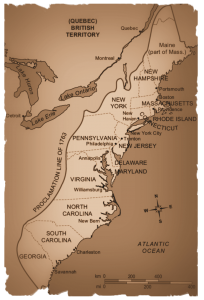
As Americans, we tend to think our history started with the Declaration of Independence in 1776 as if nothing occurred prior to that date. But, the truth is that those that came before the founding fathers influenced and inspired them. The first permanent settlement in the American Colonies was Jamestown in 1606. The Jamestown settlement became the Virginia colony. Many ships followed over the next few decades. For example, the Mayflower arrived in 1620 with English Separatists known today as the Pilgrims.
Note: In modern times we use the terms colony and colonist as in “colonists settled the Jamestown Colony”. For more than a century, the terms used were plantation and planters as in “planters settled the Jamestown plantation.”
When Roger Williams arrived on the East Coast of what is now the United States, there were only 3 colonies: a southern Virginia, a middle New York, and a northern Massachusetts colony. Roger chose to join the northern Massachusetts Bay colony.
Roger believed the government had no role in religion which is the major reason for him immigrating to New England. This was a radical idea at the time because every country in Europe had a state church. At this time, no country in Europe allowed freedom of conscience. By the time Roger died in 1683 many countries in Europe no longer had a state church including England. The colonies grew from 3 to 12. He lived and was a major player during the young formative years of America.
During Roger Williams’ time, the English named the Northeastern area of America New England. New England today consists of the Northeastern states of Maine, Vermont, New Hampshire, Massachusetts, Connecticut, and Rhode Island. During Roger’s time, the colonies were part of what was known as British America. From 1607 to 1776, British America comprised the English colonies in North America, Bermuda, Central America, the Caribbean, and Guyana.
For context, the following is a list of the original 13 colonies in America including when the English established them and their region.
- 1607: Virginia (Southern Colony)
- 1626: New York, was New Netherlands (Middle Colony)
- 1630: Massachusetts (New England)
- 1633: Maryland (Southern Colonies)
- 1636: Rhode Island (New England)
- 1636: Connecticut (New England)
- 1638: New Hampshire (New England)
- 1638: Delaware (Middle Colony)
- 1653: North Carolina (Southern Colony)
- 1663: South Carolina (Southern Colony)
- 1664: New Jersey (Middle Colony)
- 1682: Pennsylvania (Middle Colony)
- 1732: Georgia (Southern Colony)
First and Second Tables
To understand this story, you need to understand the 10 commandments in context of early colonial life. When discussing law and the separation of church and state during the time of Roger Williams, it’s important to understand the first and second tables. According to the Hebrew Bible, the “Tables of the Law”, or Stone Tablets, are the two pieces of stone inscribed with the Ten Commandments. For analysis, you can split the 10 commandments into two categories, or tables. The First table consists of purely religious matters. The Second Table consists of civil matters. The first 4 religious commandments comprise the First Table. The remaining 6 commandments deal with civil matters and comprise the Second Table. This concept of two tables is useful for discussing the role of government and church in making and enforcing all laws, not just the ten commandments. You can assign new laws to either the first or second tables. Essentially splitting laws into religious and civil.
Roger Williams and many other religious and civil leaders struggled with many questions revolving around questions like the following:
- Should the government have a say in religious matters?
- Should the church have a say in enforcing civil matters?
- Should the church enforce religious matters? If so, how strict? Can they fine? Jail? Kill?
- What actions can and should a church take to enforce their rules?

Weekly Wisdom Builder
Got 4 minutes a week?
A new 4-minute thought-provoking session lands here every Sunday at 3PM, emailed on Mondays, and shared throughout the week.
Exactly what the world needs RIGHT NOW!
The Protestant Reformation
To better understand this story, we need to understand a few terms on the popular sects of the time. In London during this time, the official religion of the church-state was the Protestant religion. For discussion let’s divide the group of dissenting voices into groups: Puritans, Radical Puritans, Separatists, and Pagans. The Puritans were English Protestants in the 16th and 17th centuries who sought to “purify” the Church of England of Roman Catholic practices. Puritans tried to change the church from within but ultimately gave in when the church demanded. Radical Puritans refused to give up their beliefs even when the church demanded and/or were too “loud”. A separatist is a protestant who wanted to separate from the Church of England. At this time, the term pagan more accurately represented all other dissenting voices. It described those that do not believe, or practiced an opposing religion such as Roman Catholic (known as papacy in R.W. writings), Judaism (Jews), Islam (Turks), etc.
Throughout time, and in every city, there are always people who challenge religion by supporting an opposing viewpoint. Authorities usually tamp down opposing viewpoints in one way or another, but sometimes an event takes place that allows new ideas to take hold. In 1534 such an event took place at the direction of King Henry the VIII. He split the Church of England from the Roman Catholic Church because the pope refused to annul his marriage to Catherine of Aragon. The King then put himself as the leader of the Church of England.
This separation or protest is known as the Protestant Reformation. A few decades that gave birth to several branches of Protestant religions — notably Lutheran, Reformed, Anabaptist, and Anglican. Anglican is by definition the version of the Protestant religion practiced by the Church of England and it has evolved over time. This time period of great unrest in Christianity opened the door for Puritans. For example, the Parliament repealed the King’s act in 1555, and put it back in 1559.
Church of England Persecution
Together the church and government persecuted those that did not live and worship by their new strict rules. Those that disagreed with the religious church-state, first table or second table, were persecuted depending on the severity of the offense. Although the church-state would generally tolerate minor religious differences such as those held by the Puritans, they could also react poorly to any given act. Most minor bad acts were handled with fines or other relatively mild punishments. Radical puritans were puritans that wanted to change the church too much and were frequently lumped in with other heretics. A heretic was someone convicted of heresy — someone who stuck to a belief the church would not tolerate. Heretics were frequently severely punished including being burned at the stake.
Separatists are those that denounced the Church of England. Separatists condemned the Church of England as an evil empire that needed to be taken down. During this time, many were persecuted. Especially those that tried to convince others of their viewpoint. If they refused to denounce their religion, they were convicted of heresy and heavily persecuted — many were fined, jailed, or banished — some were burned at the stake, hung, or beheaded.
By the time Roger Williams was born, six decades later, everybody in London including Roger grew up under the control of the Church of England. Most Catholics, Jews, Muslims, and others were either kicked out of the country, or persecuted. You were not free to “do your thing”. The church-state expected you to conform to their ideas on religious and civil matters. A good citizen fit in with their system and was expected to think the way they wanted you to think–at least in public and when challenged. Roger Williams came to despise the Church of England for its religious persecution.
Note: The idea of forcing a religion on people is very much still alive today. One example Roger Williams would have opposed is the Roman Catholic practice of Catechism of the Catholic Church (CCC). The Roman Catholic church indoctrinates children before they can possibly understand religious concepts. Their justification is that they are right, have all the answers, and know best — it’s God’s will. By 1645, Roger Williams did not support such practices. He felt one had to make a conscious choice to accept one religion or another. Don’t get me wrong, he still thought his version of religion was the right version, he just felt that you had to be convinced with valid arguments and those arguments had to wait until you were old enough to understand.
With that setup, let’s explore the life of Roger Williams…

1602: Birth and Growing Up in London
Roger Williams was born about 1602, in Smithfield, Greater London, England. His family lived in Long Lane near the site of an ancient meat market. Long Lane was a narrow passageway in the neighborhood of Smithfield in London.
Birth Note: The date 21 Dec 1602 is a common date used for the birth date of our Roger Williams. However, it is confirmed as the birthdate of a different Roger Williams who was the son of William and Alice Willyams, of Cornwall. It is NOT the birthdate of our Roger Williams who was the son of James Williams and Alice Pemberton. Very similar name coincidence, but likely NOT the birth date of our Roger Williams.
Roger grew up in London at a time of great change. He was about 4 when in 1606 King James I gave orders for a British flag to be created which bore the combined crosses of St George and of St Andrew. The result was the Union Jack flag created to celebrate the coming together of the Scotland and English crowns. The previous Cross of Saint George flag was exhibited for four centuries! I’m sure there was much discussion about tradition, change, and what’s appropriate–perhaps influencing a young Roger Williams.
Roger was about 9 years old when the King James Bible was published in 1611 under the auspices of King James I of England. The King James Bible was the accepted standard from about 1650 through the early 1900s. Changes to religious doctrine is difficult even when dictated by a King. While Roger was growing up, there was much debate and interpretation of the Bible as well as the role of government in dictating religious doctrine. This debate likely leads to his openness to various viewpoints on religion. Smithfield, the area Roger grew up in, was where heretics were burned at the stake. This fact may have shaped his eventual decision to leave England for America and his views on the separation of church and state as well as his belief that religion and the lack of religion, is an individual right.
His parents were religious, and they brought him up with the fear of God. They taught him to study and reference the Bible as the book of books, and the only foundation for religious belief and practice.
“From my childhood, now about three score years, the father of lights and mercies touched my soul with a love to himself, to his only begotten, the true Lord Jesus, to his holy Scriptures”. –Roger Williams, March 10, 1672/3 (an English Double Date)

London was a densely-packed city of 200,000. Although it faced constant challenges including poverty, tensions over politics and religion, and the threat of disease, it was a city that was constantly reinventing itself. Between about 1590 and 1613, Shakespeare wrote at least 37 plays. Roger was about 13 when Shakespeare died in 1616. For a bright child, London was a thrilling place to begin life’s journey. Many things influenced Roger including a new king, a new century, and a vibrant energetic city.
Starting about 1615 when Roger Williams was about 12, he apprenticed under Sir Edward Coke, the famous jurist. Coke was a prominent defender of free speech and one of England’s bravest defenders of human rights at a time when a new king was trying to restrict popular liberties. There is no doubt Sir Edward Coke influenced Roger Williams, and there is no doubt Roger Williams influenced America’s founding fathers both directly and indirectly.
“…I knowing what short-hand could doe as well as most in England from my Childhood, and that it is impossible for any to write Verbatim so fast as I then spake…” -Roger Williams, c. 1673
1620: James Williams, father of Roger Williams Dies
According to the 1894 G.B. Thayer Book, Roger’s father James Williams was a merchant tailor in London, England. He was probably born at St. Albans, Hertfordshire. In about 1590 he married Alice Pemberton, and soon after moved to and went into business in London. He died in 1620, leaving his property to his wife and children including Roger.
Fathers usually make a big impression upon their children. When James died September 7, 1620, Roger Williams was about 17 or 18 years old. James Williams made provisions for the distribution of money and bread among the poor on the day or day following his funeral. I can’t help but imagine that actions of this nature influenced Roger Williams.
1621-1627: Prep School and College
Roger Williams’ patron and mentor Sir Edward Coke noticed Roger’s shorthand and sponsored him to Sutton’s Hospital, now Charterhouse. He entered the school on June 25, 1621, and graduated July 9, 1624. Prior to graduating, he entered Jesus College on April 30, 1624. By July 7, 1625 he was attending Pembroke College, Cambridge where he earned a Bachelor’s of Art degree in 1627 from Pembroke College, Cambridge in January 1626. After he achieved his B.A. degree, he started studying law under his patron Sir Edward Coke. After a short time, he switched to theology.
1629: Anglican Minister Roger Williams
Roger was ordained a Protestant minister in the Church of England in 1629 and was invited to become the family chaplain in the grand home of Sir William Masham at Otes in the county of Essex. Many Puritan leaders lived in Essex and were struggling against a growing number of restrictions from the new King Charles I. Many of the Puritans that traveled to New England emigrated from Essex during this time.
Roger Williams: A Puritan and Separatist
From a young child, Roger Williams developed his own thoughts and stuck to them if he felt he was right. Tradition says that Williams told his family he was a Puritan at about age 8. His parents were not, so conflict was part of his upbringing. Although he would always listen to a valid argument, he was stubborn and vocal if he disagreed with you. All his life he managed to skirt the edge of protest and was rarely persecuted. He did have to flee London in Dec 1630, and was banished by order of the General Court on 3 Sep 1635 (N.E. Vind, 1884), but he kept up dialogue with everyone and anyone that would listen. In addition, he returned to England twice and pushed for religious freedom.
At times he acted as a Puritan Minister. He both practiced separatism and tried to influence Puritan Ministers, and the Church of England. Surprisingly, he planted enough freedom of conscience seeds during his life to take root. Although one man could not take full credit, one could legitimately argue that modern society all around the world owes their freedom of conscience to this one man.
Roger and Mary are Married
At the age of about 26, Roger married Mary Bernard on December 15, 1629, in High Laver, Epping Forest, Essex, England when she was 20 years old.
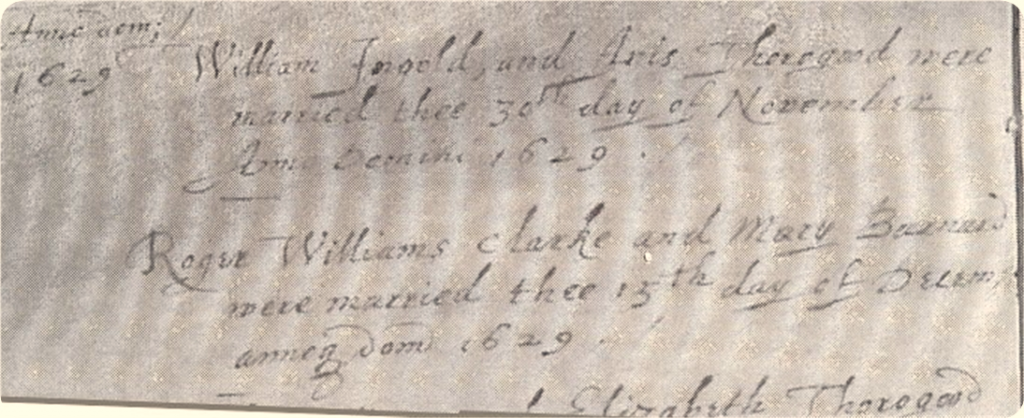
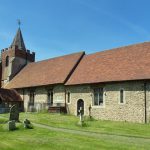
Mary Bernard was born in London, England, on September 24, 1609. Mary’s last name is sometimes given as Barnard, but according to many historians, she was the daughter of the clergyman, Richard Bernard. Mary was a maidservant in the nearby grand estate belonging to Lady Joan Barrington.
The couple married in the church of High Laver. That small church is also historic for another reason – its cemetery contains the grave of the philosopher, writer, and defender of human rights, John Locke. Many historians consider John Locke the father of liberalism. Roger Williams influenced John Locke, especially in the area of religious freedom. Roger Williams went well beyond Locke in promoting religious freedom. Locke, for example, did not want to grant toleration to Catholics nor atheists.
Roger Williams Family Chart
The following chart lists Roger and Mary’s children, siblings, and parents. Roger and Mary had 6 children in 10 years.
Roger & Mary Williams leave for America, Dec 1630.
1631: From England to America
Roger Williams left England because he felt they were on the wrong path. Specifically, he took great offense at religious persecution as well as persecution for thinking or believing something. For sure he felt individuals had a God-given right to believe whatever they believed. Through valid arguments, you can attempt to change their beliefs, but ultimately it is their choice. It is likely that if Roger Williams stayed in England, he would have been persecuted.
Roger Williams left England for New England in 1630. This was about 5 years after King Charles I came to power. At the time, there was a general distrust of Charles’ religious and political policies which eventually led to a civil war starting about 1642 and ending with Charles’ beheading in 1649.
Roger and his wife Mary traveled on the “Lyon” ship. They traveled along with about 20 passengers from Bristol, England and landed at Salem, Massachusetts. The ship set sail from Bristol on December 1, 1630, and after 65 days at sea arrived on February 5, 1631. Only one passenger died during the journey. The son of Mr. Waye fell overboard during a storm and although he struggled for about 15 minutes, they could not rescue him before he went under. The ship was also carrying about 200 tons of goods. When the ship Lyon arrived, it had to navigate around and through a great drift of ice. Many of the poor lived in tents along the shore and had scurvy and many died. The Lyon was carrying lemon juice which helped many of the poor recover their health quickly.
Map depicting tribal distribution in southern New England, circa 1600; the political boundaries shown are modern:
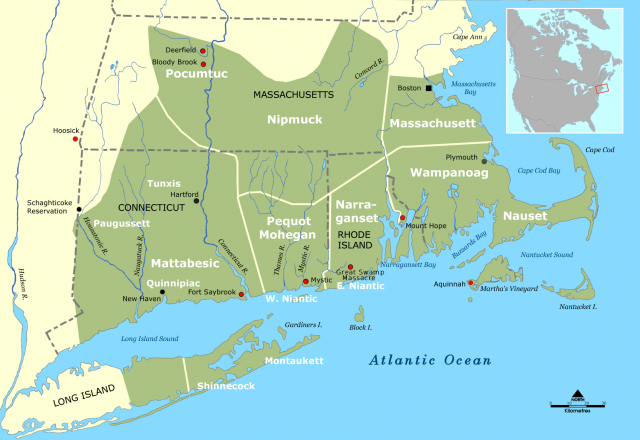
1631-4: Plymouth
Roger resided in Massachusetts for a very short time, but after some discontent moved to Plymouth. Williams and his family settled in Plymouth for about 3 years. Initially, he was offered to join their church and hold a position as the teacher. He refused because the church still held communion with the Church of England. At this point, it was clear Roger Williams was a separatist. With no position available, he focused much of his energy during this time to farming. He eventually became the assistant to Pastor Ralph Smith and was well-received by all in the beginning. After all, Roger Williams was a highly educated and eloquent Puritan minister at a time when the young colony needed such people.
For at least two years through 1632, Roger Williams was a leading figure in the community. The leaders would get together for one reason or another and debate with Roger Williams. It was their custom that Roger Williams would propose a question or topic, and they would each speak on the issue.
However, tensions rose in 1633 and by November 1633 Williams was removed as the teacher at the Plymouth church. The Massachusetts Bay Colony was inhabited by Puritans who did not tolerate any other form of religion. These puritans left England primarily because the Church of England persecuted them for their differing beliefs. They set up their version of the Church of England in the Massachusetts Bay Colony and then persecuted those that did not believe as they did. They were hypocrites from the very beginning.
Williams was disappointed that Puritans in America were going down the same path as the Church of England and persecuting dissenters. Many who came to the colony were trying to escape persecution. Eventually, he started putting forth his rebellious ideas of separation from the Church of England and anibapistry and was met with resistance. When tensions rose high, he then sought to transfer to the Church of Salem. The Church of Plymouth granted the transfer to Roger Williams and all that followed him.
1633: Teacher and Minister of Salem, The Birth of a Rebel!
By December 27, 1633, Roger Williams moved to Salem and was the assistant to Pastor Samuel Skelton (1592-1634). He moved there at a time when Pastor Skelton was ill. The Pastor died soon after Roger arrived. Roger Williams was elected their teacher and was finally empowered to preach with authority. Over the next year, Roger preached separation of church and state, and other radical ideas of the time. Roger preached that the Church of England was wrong to force non-believers such as atheists, Jews, Muslims, etc. to pray, and it was wrong to make them support the Church of England. Roger felt strongly that the Church of England was an evil enterprise and he encouraged civil disobedience. Roger Williams refused to take the oath of Salem, and he encouraged others to do the same. He preached against the very authority of the Salem Colony. He led the civil disobedience with a letter-writing campaign by his followers. They wrote letters to the churches of Boston, Charlestown, Newtown, etc. Some acknowledged their error and that brought great satisfaction to Roger Williams.
“Mr. Williams…affirmed…that there should be a general and unlimited toleration of all religions, and for any man to be punished for any matters of his conscience, was persecution.” –New England’s Memorial, Nathaniel Morton (1669).
In 1634 tensions were high because Roger Williams was pushing all to separate from the Church of England here in New England and in old England. At this time, Roger was still a Protestant Minister. He was a Puritan Minister trying to change the church from within but became a Separatist Minister when he failed, but he was still a Protestant Minister. Roger refused to attend church and wrote a letter that was read in the church. It said that if they refused to separate from the Church of England, he would separate from them. He would not pray, nor even say thanks at mealtime with anyone that attended the antichristian church. This included his wife and family who still attended the church. He did, however, seek out anyone that had not yet heard his arguments. Roger Williams had little tolerance, nor time for those that supported religious persecution and had already heard his arguments. The stronger their zealous for persecution, the more Roger would avoid them. (This one habit likely led to much of his success. How many of us keep talking with people that are exercising stubborn ignorance.)
Although Roger Williams was generally arguing for freedom of and from religion, he was in a debate about specifics. Around this time those specifics were:
- The church should not force non-believers to pray.
- The church should not force non-believers to pray with their families.
- The government should not force non-believers to take an oath to the church.
- The government should not force citizens to join the church.
- The government should not punish nor rule over the church regarding religious matters (the first table), but the church must still follow civil laws (the second table).
Roger than started holding church in his home on the sabbath and other days. The magistrates responded by sentencing Roger to banishment for disturbing the peace, both church and commonwealth.
“Everyone should have liberty to worship God according to the light of their own consciences.” –Roger Williams
Our Colonies, Religious Persecution, An American Tradition
Some English fled to the British American colonies to escape religious persecution. Some fled to practice their own form of religious persecution. Roger struggled with the intolerance of some of the colonies, and his viewpoints upset them as well. He did not believe the King of England had the right to grant lands in foreign countries. He believed the land belonged to the native inhabitants. Roger also thought churches having communion, an alliance, with the church of England, were criminal and led civil disobedience against them. Roger struggled with their intolerance and they struggled with his different viewpoints.
Endicott and the Red Cross
In 1634, Roger Williams gave a famous sermon that preached that the St. George Cross in the colony flag was a symbol of popery. This sermon convinced John Endicott, one of the leaders, that the St. George Cross in the colony flag was a badge of idolatry. Endicott removed the cross which was an act of vandalism. The local legislature removed him from holding any office for one year. 1635 was the only year he did not hold an office. The legislature allowed the standard-bearers of each town to adopt any flag they wish. Without exception, every town adopted the red flag with a white canton. There are many references to this flag over the next 50 years. Two hundred years later in 1837, the flag is the subject of Nathaniel Hawthorne’s story Endicott and the Red Cross, one of his Twice-Told Tales.

I wonder what Roger Williams and the founding fathers would have thought when “In God We Trust” first appeared on the 1864 two-cent coin? I think it’s clear they would have objected strongly and argued against it. What about the pledge of allegiance? Roger Williams refused all oaths and would have likely refused the original pledge of allegiance adopted in 1892, which was 116 years after the founding fathers declared independence for similar reasons. Finally, both Roger Williams and the founding fathers would have objected to Eisenhower adding “Under God” to the pledge in 1954.
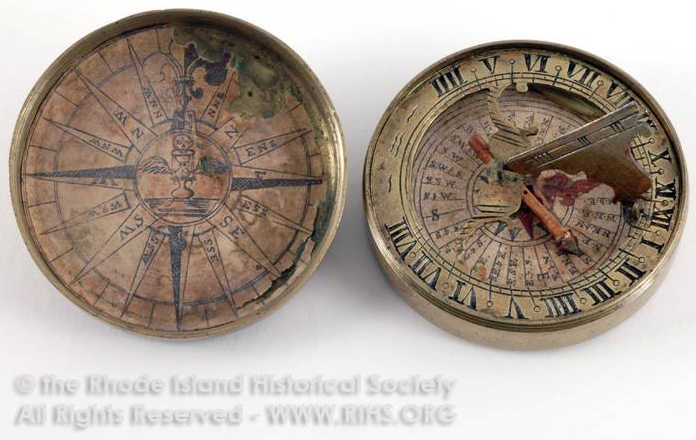
Roger Williams Banished from the Massachusetts Bay Colony
His views on religious freedom and tolerance, coupled with his disapproval of the practice of confiscating land from Native Americans, earned him the wrath of the colony. Williams challenged the very existence of the colony and refused to take their oath. The colonial government refused to grant land to the Williams’ church, and Roger directed members to write letters in open rebellion. The colonial government could not let that stand and convicted him of sedition and heresy.
“…so the next morning the court sentenced him to depart out of our jurisdiction within six weeks.” –November 1, 1635
On November 12, 1635 (modern calendar), the court banished Roger Williams. He had six weeks to leave or he would be sent back to England. With that threat, he faced a difficult choice. In January 1636, Roger left the colony–some say escaped.
“Mr. [Williams] the pastor of the church being at the time absent upon a voyage to England.” –New England’s Memorial, Nathaniel Morton (1669).
Roger flees into the wilderness with very little leaving his wife Mary and his 29-month-old first child Mary (my 9th great grandma). We know he had his compass and sundial, and that he journeyed to Narragansett Bay with his young devoted servant Thomas Angell. The two wandered for almost fourteen weeks through the winter and into the spring of 1636, encountering hardships along the way. Francis Wickes joined them at some point during their 14-week journey, or soon after they arrived at Providence. Either way, in January 1636 in the middle of winter he ventured into the wilderness, met, and lived with local native tribes for several months. They welcomed him because they were aware of his viewpoint that the King could not take their land.
“I was sorely tossed for one fourteen weeks in a bitter winter season, not knowing what bed and bread did mean.” –Roger Williams
One could argue Williams was a Separatist Minister who fled England for the new world in order to escape persecution. When does a radical Puritan become a Separatist? That’s a difficult question. Perhaps when they are banished or voluntarily leave the Church of England. I think it is fair to say that Roger Williams was a Puritan Minister up until his time of banishment in January 1636. After that, he for sure was a Separatist Minister who preached separation from the Church of England’s Protestant religion.
Roger Williams, A True Friend of the Native Americans
Roger Williams was well known for his true friendship with the Native Americans. The following quote is from a deposition Roger Williams recorded about 1680:
“I testify…that about fifty years since, I, coming into the Narragansett country…I declare to posterity that…I never got any thing out of Cononicus but by gift…I desire posterity to see that when the hearts of my countrymen…failed me…the…heart of Cononicus to love me as his son to his last gasp…and all the Coweset Sachems my friends…Ousamaquin also…my great friendship with him at Plymouth, and the authority of Cononicus, consented freely…all the…lands I procured of Cononicus, …I never denyed him nor Meantinomy whatever they desired of me as to goods and gifts, or use of my boats, or pinice…”
Personal Comment: What a shame that future generations all across America lost this spirit. I think it would have been great to divide up the riches of America with Native Americans who were here long before the colonists. How great it could still be if we would carve out some amount of penance for descendants of those we harmed so greatly. America is a great and rich country with a lot of open land and tremendous wealth. Surely we can carve out some amount of money and land as gifts to the descendants of those we’ve harmed including Native Americans and African Americans.
What did Native Americans think of Europeans?
Contrary to common misconceptions, Native Americans were cleaner, stronger, more athletic, and better looking than Europeans. Native Americans thought Europeans were physically weak, sexually untrustworthy, atrociously ugly, and dumb compared to themselves.
The personal hygiene of Europeans was foul-smelling. Europeans at the time thought bathing made you sick and were amazed by the Native Americans’ interest in personal cleanliness. Native Americans viewed Europeans as dirty and smelly. Little did they know that Europeans were the ones that brought over smallpox which killed 90% of Native Americans before 1640. If the worst plague in the history of mankind had not wiped out 90% of Native Americans, the battle for the territory that is now the United States would have unfolded much differently.
1636: Founder, Providence Plantations
Roger ended up in the flat rolling hills and lowlands of what is now the state of Rhode Island. He negotiated with the local Indians and came to an agreement with the local sachems, the Algonquians tribe chiefs. Soon, many from Salem, Plymouth, and other places followed him to his newly formed Providence Plantations. When possible, Roger held services outside; otherwise, in one of the members’ homes.
Legend says, when Roger Williams arrived by canoe on the banks of what is now Providence, Rhode Island, the Native Americans greeted him with…
“What cheer, netop?”
I do not know if that story is true, but it was a common greeting and included on page 2 of Roger Williams’ Key book:

He founded the Providence Plantations in 1636 and signed the land deed with the local natives two years later. Rhode Island was the 5th American colony and the second colony in the New England area. Most historians use 1636 as the date of the start of the Rhode Island colony. At the time, the English established Virginia, New York, Massachusetts, and Maryland colonies only. In the beginning, Roger Williams called it New Providence but eventually settled on Providence Plantations.
Roger and other settlers agreed on an egalitarian constitution providing for majority rule in civil things, with liberty-of-conscience on spiritual matters. They stressed the separation of religious and civil affairs.
Other freethinkers, progressives, and liberals ended up in the Rhode Island area which became known as a safe haven for free thinkers. For example, the famous early colonist Anne Hutchinson who was banished ended up in Rhode Island. The magistrates banished her from the Massachusetts Bay colony two years after Roger Williams on 2 Nov 1637. The magistrates cited her religious and feminist beliefs including her belief that one could worship without a minister.
The Lively Experiment
Roger Williams established Providence and guaranteed liberty of conscience and encouraged respect of individuals, toleration of others, equality and free discussion of opinions. Essentially, Roger Williams believed that what you think and say should not fall within civil laws.
Roger Williams, The First Abolitionist
Some say Roger Williams was the first abolitionist and there is evidence that this is true, but for sure, Roger and Rhode Island were more enlightened than other colonies of the time. I think it is fair to say that Roger Williams opposed slavery generally and fought against specific aspects of it including against racially based slavery.
Roger Williams opposed unfair slavery. He did support slavery to repay debts but only when limited to a reasonable amount of time, and never on one’s children. Everyone was born free in Roger Williams’ eyes. But, he was okay with slavery to pay a debt or punishment so long as the debt or crime was true, defined with an endpoint, and the enslavement fair. He also did not support the taking of Indians in war. At the time, it was common to enslave any conquered Indians.
The following passage documents the desire of the Massachusetts court to seek the help of Roger Williams in returning slaves brought to New England by Captain Smyth.
“In 1645, the General Court of Massachusetts, which then exercised jurisdiction over the settlements at Pascataqua, ‘thought proper to write to Mr. Williams’, residing there, understanding that the negroes which captain Smyth brought, ‘were fraudulently and injuriously taken and brought from Guinea, by captain Smyth’s convection, and the rest of the company; that he forthwith send the negro, which he had of captain Smyth, hither ; that he may be sent home; which this Court do resolve to send back without delay. And if you have any thing to allege, why you should not return him, to be disposed of by the Court, it will be expected you should forthwith make it appear, either by yourself or your agent.”
About the same time, viz. 1645, made [a law], ‘prohibiting the buying and selling of slaves, except those taken in lawful war, or reduced to servitude for their crimes by a judicial sentence ; and these were to have the same privileges as were allowed by the law of Moses.” –page 195, Mass. Hist. Collection, S1, vol 4, 1795.
In 1652, Rhode Island passed the first abolition law in the colonies banning slavery. Unfortunately, the law was difficult to enforce and nearly useless. By 1774, the slave population of Rhode Island was 6.3 percent, nearly twice as high as any other New England colony.
In March 1676, the colony passed a law that no Indian in this colony can be a slave except to pay their debts and are to be treated the same as the English and not taken in war. This was passed in the middle of the King Philip’s War!
Unfortunately, Rhode Island became a slave hub a few decades after Williams’ death in 1683. Much later, about 90 years after Roger Williams passed, Rhode Island passed a law prohibiting importation of slaves into the colony, and that all black babies born in the colony are free after a certain age.
1637: Pequot War
The Pequot War took place from 1636 to 1637 in New England between the Pequot tribe and the colonists who were allied with local tribes. The Pequot went up against the colonists of the Massachusetts Bay, Plymouth, and Saybrook colonies and their allies from the Narragansett and Mohegan tribes. In 1637, Roger Williams held peace talks in his home negotiating the end of the Pequot War.
Years later, he wrote:
‘Three days and nights my business forced me to lodge and mix with the bloody Pequot ambassadors, whose hands and arms methought reeked with the blood of my countrymen murdered and massacred by them on Connecticut river.” –Roger Williams
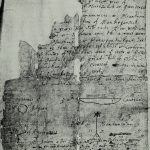
1638: Land Deed Signed
In 1638 Roger Williams purchased the land on the north side of the Pawtuxet River from the local Native Americans. He then sold the land that same year to William Arnold and William Harris for the price of a cow. He signed the land deed with the sachems, Canonicus, and Miantonomy tribes on March 24, 1638.
The “Towne Evidence” to the right was the original land deed drawn up by Roger Williams and the Sachem. Unlike most early settlers, Roger Williams arranged to buy the land from the local natives for a fair price. He then arranged to transfer the land to those that settled the land with him.
The First Providence Government
They formed the first agreement or covenant for the government of Providence that same year on April 7, 1638. Providence is the first place in modern history where citizenship and religion were kept legally separate. Providence provided religious liberty and separation of church and state. This was combined with the principle of majoritarian democracy in Providence and was a template for modern American life. Later, in 1802, Thomas Jefferson used Roger Williams’ phrase “wall of separation” to describe the separation of church and state in the USA. Providence and Rhode Island became a refuge for religious minorities including Quakers, Catholics, Baptists, Jews, Antinomians, and atheists, etc. Pretty much anyone who fled from religious intolerance or persecution.
Each head of household was given the same amount and quality of land, about six acres. There was no big house at the top of the hill with the poorer households huddled together. Each of the settlers started the same, making Providence a settlement of equals.
In the other settlements, you had to be a member of the church to vote, but not in Providence. In addition, no taxes were collected to support a church–no state church!
Thomas Olney: Thomas was also my 10th great grandpa! His grandson William Olney married Roger’s granddaughter Catherine Sayles. Thomas was one of the men asked to leave the Massachusetts Bay Colony with Roger Williams in 1636. Later in 1638 Thomas signed the first Providence compact and received land in Providence. He was one of the 12 persons to whom Roger Williams deeded land on October 8, 1638. He was also one of 39 who signed an agreement for a government in Providence in 1640.
1636-38: The Case of Verin, Religious Freedom, and Women’s Rights
Joshua Verin and his wife Jane moved from Salem to Providence and lived next to Roger Williams–neighbors for several years. Joshua chose not to attend church, a crime in the other colonies. This is the first example of the exercise of the separation of citizenship and church in America.
After a while, his wife Jane started attending church despite her husband’s demands not to attend. During this time, women’s rights did not exist. According to the Bible, a man’s wife was subjugated to their husband. In this version of a “bright city on a hill”, the accepted belief was that intelligence was given to men, not women. Women were not allowed to speak in church, and were seen as intellectually inferior starting with Eve’s failing in the Garden of Eden. Roger Williams did not believe this concept. He believed in a woman’s right to choose their own path and in their freedom of conscience.
Sadly, Jane’s husband Joshua beat her because she did not conform to his wishes.
In May 1638, Williams writes to John Winthrop:
“…he hath trodden her under foote tyrannically and brutishly: which she and we long bearing though with his furious blows she went in danger of Life…”
This incident was the first major dispute the young colony faced. Joshua believed that his Godly right to beat his wife was given to him by God and documented in the Bible. Sadly, even today, this concept creeps into our society now and then and men use the Bible as an excuse to repress and beat women.
The town members met to decide Verin’s fate and punishment for beating his wife and for violating his wife’s liberty of conscience. Some, like William Arnold, argued that punishing the husband would breach an ordinance of God.
Note: This William Arnold is the father of Benedict Arnold. Both figured prominently in the early history of Providence. This Williams Arnold is the 3rd great grandfather of the Benedict Arnold who was a traitor during the Revolutionary War.
The majority vote of the colony was to banish Joshua Verin for violating his wife’s freedom of conscience and to provide a safe haven for his wife.
In town records:
“the major vote of us discard him from our Civill Freedome.”
Joshua Verin returned to Salem, but sadly, he forced his wife to accompany him. Of this Roger wrote:
“He will hale his wife with ropes to Salem, where she must needes be troubled and troublesome as differences yet stand. She is willing to stay and live with him or else where, where she may not offend…”
This is the first time a legal precedent was established supporting the right of a woman to act independently of her husband and in accordance with her own conscience.
1639: Roger Loses Faith; Converts from Protestant to Baptism
In late 1638 or early 1639, Roger Williams continued to question his Protestant faith. He questioned the Puritan path he was on and even stopped holding and going to church. During this time, Roger and three others became seekers. They did not belong to any church, but abided by one principle: everyone should have the liberty to worship God according to the light of their own consciences. After a time, two of the three left. Eventually, Roger Williams lands on the baptist faith and starts holding services in his home and outdoors again.
Note 1: According to the Winthrop journal, the slightly more precise time frame for Roger Williams’ conversion to Baptism is Apr, May, Jun months of 1639.
Founder, First Baptist Church in America
The First Baptist Church in America is the First Baptist Church of Providence, Rhode Island. It is the oldest Baptist church in America and was founded by Roger Williams in 1638. Prior to this point, Roger held services in his home for nearly a year. He converted his congregation into a Baptist church in 1638. For the next sixty years, the congregation met outside in nice weather or in a member’s home. Baptists in Rhode Island through most of this time felt building a church reflected vanity.
“About this time [Sep 4, 1639] Roger Williams, having become a baptist [prior], establishes the first baptist church at providence…” –Massachusetts Hist. Collections, p. 210, v. 10, 1843.
The 2nd Baptist Church in America
The 2nd Baptist Church in America was founded in 1644 by John Clarke (1609-1676) six years after Roger Williams founded the first one.
John Clarke immigrated to Massachusetts Bay in 1637 and was forced into exile shortly after. He learned about the Rhode Island area from Roger Williams. Acting as an intermediary, Roger Williams helped William Coddington, John Clarke, and other settlers purchase land from the Narragansett Indian tribe and establish Portsmouth in 1638. They purchased the land for the price of “forty fathoms of white beads, ten coats, and twenty hoes.” Clarke is the second of the 23 signers of the Portsmouth Compact. A few years later in 1644, John Clarke established the second Baptist Church in Newport.
1643-44: English Legal Standing, Chief Officer
During the 1630s and 1640s, the Massachusetts Bay Colony attempted to extend its authority to settlements in the area. So, when Roger Williams founded the Providence Plantations, his land was no exception. Roger’s settlement was secured by negotiations with the local Native Americans but had no English legal standing. After years of negotiating, Roger finally traveled to London in 1643 to settle the matter. Since the Puritans refused him passage, he was forced to travel south into Dutch territory to seek passage back to England.
1643: Kieft’s War and Roger Williams
In about late January of 1643, a skirmish between the Dutch and the Mohawk tribe broke out. A drunk Indian killed an old Dutchman. The Dutch wanted to put the Indian on trial, but he could not be found. Rather than proceeding with an investigation, as usual, the Europeans decided to massacre some Indians. The Dutch attacked and killed about 30 Mohawk Indians. A Dutch Captain William Kieft heard about the skirmish and got a commission from the Virginia governor to kill as many Mohawks as he can. He massacred about 80 men, women, and children bringing the total dead on the Mohawk side to about 110. To say the least, the investigation into a homicide was not going well.
The Mohawks retaliated by burning several farms, killing cattle, and killing about 20 men, women, and children. They successfully pushed the Dutch back to their fort who were forced to call in the English for aid.
Captain Underhill was sent to meet with the Dutch and was so upset and disgusted at the Dutch and Governor for their actions. Captain Underhill felt the Governor made a mistake in hiring Captain William Kieft to kill as many Indians as he can including women and children. Both captains, Underhill and Kieft, met with the Governor. The meeting did not go well. A subordinate of the governor killed a subordinate of Captain Underhill when he pulled out a gun and tried to shoot the governor. The shot barely missed only because someone jumped at the shooter as he shot. Captain Underhill survived the encounter but was put in prison. The head of Captain Underhill’s subordinate was then displayed on the gallows.
The governor then had to have protection during the rest of the war, the governor had to have as many as 50 soldiers around him anywhere he went because of surprise attacks.
Roger Williams played an early role in the Kieft’s War. Luckily for all, the famed Roger Williams was in New Netherland, now New York, to catch a ship back to England when he heard of the skirmish and massacre–likely in early February 1643. He skillfully negotiated a peace treaty between the Dutch and the Native Americans. If this was the end of the story, then Williams would be a hero. Unfortunately, the peace did not hold. Williams left on a ship for England as planned, and right on queue, entitled racist Europeans broke the peace and attacked the Indians again on 23 Feb 1643. This led to a two-year war with many casualties on both sides.
The native attacks caused many Dutch settlers to return to Europe. The Dutch West India Company’s confidence in its ability to control its territory in the New World was shaken. In 1647, Captain Kieft was called back to the Netherlands to answer for his crimes, but he died at sea when the ship he was on sank.
Personal Comment: Immediately after negotiating this treaty, Roger Williams was on a Dutch ship to England. On the trek, he wrote his “Key” book. I wonder if the obvious language barrier that led to so much misunderstanding and many deaths inspired him at least in part. I also wonder how he felt when many months later, he found out his peace deal broke down.
Roger Williams’ Return to England
He returned to England at a time when the newly formed and historic Long Parliament had existed only about four years.
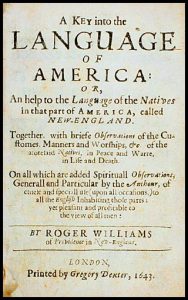
1643 Book: A Key Into the Language of America
In 1643, Roger Williams wrote A Key Into the Language of America, A help to the language of the natives in that part of America called New England. He wrote the book mostly while on the two-month voyage to England. It was on sale by September 7, 1643, and made him more famous. His readers knew he was banished from the Massachusetts Bay Colony.
He wrote down what he learned about the Narragansett culture and language. This 17th-century book describes the Native American languages in the New England area (largely Narragansett, an Algonquian language). At the time of this book, New England consisted of the Massachusetts, Rhode Island, Connecticut, and New Hampshire colonies.
The book helped to popularize numerous American Indian words into the English lexicon including:
- Moccasin
- Moose
- papoose
- powwow
- quahog
- squash (askutasquash)
- squaw
- succotash
R.W. Knew Seven Languages and Shorthand
Roger Williams spoke at least seven different languages: English, French, Latin, Dutch, Greek, Hebrew, and Narragansett.
Roger also knew shorthand. He was trained in shorthand in London. Over time, he built his own proprietary shorthand based on 28 symbols, but he also improvised and at times integrated some of the seven languages he knew. For centuries some of his cryptic shorthand remained untranslated. In 2012, scholars cracked his code and several new writings by Roger Williams have appeared. Roger’s thoughts are entering society 300 years after his death!
1644: Return to New England
Roger received a parliamentary Commission for Plantations patent in 1644, and returns to New England landing at Boston on September 17, 1644 (See Savage’s Winthrop, vol. 2, p. 193). The commission united Providence with Portsmouth and Newport as “The Incorporation of Providence Plantations in the Narraganset Bay in New England”. In May 1647, the three towns plus Shawoment (now named Warwick) formed a government under this commission.
1644 Book: The Bloudy Tenent of Persecution
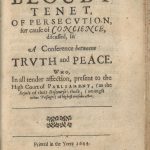
In 1644, Williams published The Bloudy Tenent of Persecution. Historians consider it his most famous work. He wrote Bloudy after arriving in London in midsummer 1643. It was on sale by July 15, 1644, and he left England for Providence a few weeks prior to the publication. His trip back to New England took a bit longer than other ships and news and copies of his book beat him back to New England. He arrived in triumph and cheer.
The book was a fierce attack on religious and political intolerance in both Old England and New. He advocated for free thought and belief because he felt that punishing non-believers was not part of any religion. Furthermore, he believed the government should be separate from religion.
Roger Williams advocated for and wrote extensively about…
…a hedge or wall of separation between the Garden of the Church and the Wilderness of the world.
His ideas raised questions and challenges but his ideas endured over time.
Roger Williams promoted the concept of liberty of conscience, of freedom of and from religion.
In the preface of his Bloudy book, Roger Williams demonstrated how his concerns differed from the aristocratic tradition
“Two mountains of crying guilt lie heavy upon the backs of all men that name the name of Christ, in the eyes of Jews, Turks, and pagans.
First, the blasphemies of their idolatrous inventions, superstitions, and most unchristian conversations.
Secondly, the bloody, irreligious and inhuman oppressions and destructions under the mask or veil of the name of Christ, etc.”
In the above passages, Roger Williams writes about his concern with how “others” perceive Christians, and how Christians use their religion to justify punishing those that did not believe.
In 1802, Thomas Jefferson authored a letter with the following passage:
“Believing with you that religion is a matter which lies solely between Man & his God, …the legitimate powers of government reach actions only, & not opinions, …the whole American people which declared that their legislature should make no law respecting an establishment of religion, or prohibiting the free exercise thereof, thus building a wall of separation between Church & State.” –Thomas Jefferson, January 1, 1802
1645 Book: Christenings make not Christians
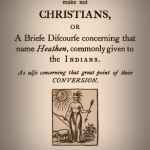
Subtitle: A Briefe Discourse concerning that name Heathen
Not only did Roger Williams write the first book on the local native Americans, but he also supported them in ways that were 400 years ahead of his time. To this day, there is a Native American name controversy of which Roger Williams wrote a book on in 1645.
In 1645 Roger Williams wrote this small 25-page book. In it, he documented that the English and Dutch refer to native Americans as heathens and not always just to mean non-Christians. For example, Roger said they frequently call them “heathen dogs”.
To counter, Roger writes,
“this word Heathen is most improperly sinfully, and unchristianly so used in this sense.”
Roger was also upset with the common phrase of the time,
“it is better to kill 1,000 indians then to be endangered or troubled with them.”
To counter, Roger said that only Jews were part of God’s holy nation. All others including famous states, kingdoms, civilized, and uncivilized are the same. He argues that the world does not belong to the Roman Monarchy. He argues that everybody is equal. He mentions Europe, Asia, Africa, and America. He names Jews, Muslims (Turks), etc.
Regarding Native Americans in general, he writes,
“…they are intelligent, many very ingenuous, plaine-hearted, inquisitive and (as I said before) prepared with many convictions, etc.”.
1651: Unrest in the New Colony
Some, including William Coddington of Newport, mentioned above, were unhappy with Roger Williams’ new colony. Seven years later in 1651, William Coddington received a commission to govern for life Aquidneck and neighboring Conanicut Island. Roger Williams responded by returning to England with John Clarke the same year in 1651 to defend the colony’s charter. Just weeks earlier the parliament was busy with religious matters taking up the powers of the church. Although Roger Williams was there to defend his young settlement, he couldn’t help but get involved. Within weeks he wrote and printed several pamphlets framing the issues of the day and supporting religious tolerance.
Roger Williams argued:
- Ministers should be supported not by legal provisions, but by voluntary donations.
- The church should not force their religion on others, nor persecute non-believers.
In 1653 and 1654 word was sent to Roger Williams of disruption back at his beloved colony. For example, Coddington was trying to usurp governing power. Roger’s returned in 1654 to use his considerable negotiating and people skills to settle the dispute. John Clarke stayed in England to continue to try and get a Royal Charter.
The town meeting records for December 1652 notes one such letter from Roger’s youngest sibling Robert Williams:
“…by Robert Williams…hereby signify…that the…Committee at Warwick hath declared disloyalty unto the Commonwealth of England…24 Dec 1652…Letter…sent unto our agent Mr. Roger Williams in England…”
Here is the clip from “The Early Records of the Town of Providence”, volume 15, page 60.
Robert Williams likely in Providence by 1640 and lived the rest of his life in Providence and Newport. He was involved in colony business, worked various positions, and was even nominated for President of the Colony for at least one of the elections.
1654: President of the Colony
Roger Williams was president of the colony from 12 September 1654 to 19 May 1657. Upon his return, Roger Williams was elected the 9th President of the colony from 1654-57. He was able to reunite the factions in the area including Pawtuxet rejoining in 1658. Before and after he held many colony and town offices. During this time Roger’s convinced Massachusetts Bay Colony to give up claim to lands and established a new charter that brought confidence to the young community.
![]() Interesting Tidbit: Benedict Arnold (1615-1678) followed Roger Williams as 10th President of the Colony. This Benedict Arnold is the great-great-grandfather of the noted Benedict Arnold who was a traitor during the Revolutionary War.
Interesting Tidbit: Benedict Arnold (1615-1678) followed Roger Williams as 10th President of the Colony. This Benedict Arnold is the great-great-grandfather of the noted Benedict Arnold who was a traitor during the Revolutionary War.
1655: Jewish Settlers Welcomed at Providence
The colony shocked the other colonies by welcoming Jewish settlers. Roger Williams even visited with them in Newport. In 1655, Roger Williams wrote a letter in response to the charge that he advocated infinite liberty of conscience. The story in the letter has become known as the Parable of the Ship and is used as an illustration of separation of church and state, of who should enforce the first and second tables.
Here is the relevant passage–edited for clarity:
“…There goes many a ship to sea, with many hundred souls in one ship, …and is a true picture…[of a] society. …papists and protestants, Jews and Turks, may be embarked in one ship; …All …I pleaded for… [were these] two hinges –
[FIRST] that none of the papists, protestants, Jews, or Turks, be forced to come to the ship’s prayers or worship, nor compelled from their own particular prayers or worship, if they practice any.
[SECOND] …the commander of this ship ought to command the ship’s course, …and also command that justice, peace, sobriety, be kept and practiced, both among the seamen and all the passengers. If any of the seamen refuse to perform their services, or passengers to pay their freight; if any refuse to help…towards the common …defense; if any refuse to obey the common laws …if any shall mutiny …if any should preach…that there ought to be no commanders or officers…the commander …may judge…and punish such transgressors…”
It would be another 108 years before the first Synagogue is built in America. On December 2, 1763, members of the Jewish community of Newport, Rhode Island dedicated the Touro Synagogue, the first in America.
The naming of Patience, Prudence, and Hope Islands
Williams named the islands in the Narragansett Bay after Christian virtues: Patience, Prudence, and Hope Islands.
1658: Roger Williams Delivers Hope Island
In March 1658 at the Rhode-Island General Court at Portsmouth, Roger Williams presents the deed for Hope Island. It is a gift from Meantinomy, late Sachem. They formed a committee which gave Hope Island to Roger Williams peaceably.
1663: Founder, Colony of Rhode Island and Providence Plantations
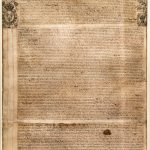
In 1663, King Charles the Second granted a Royal Charter to the Colony of Rhode Island and Providence Plantations uniting Providence, Warwick, Newport and Portsmouth. The colony became the State of Rhode Island after the Revolutionary War. The 1663 Royal Charter was in force from July 8, 1663, until the adoption of the R.I. Constitution in May 1843.
John Clarke, who stayed behind in England worked hard and deserves much of the credit. Roger Williams returned in 1654 to calm a disruptive rebellion in his beloved colony and never returned to England.
Interesting Tidbit: Under this Royal Charter, the leader of the colony is now a governor, no longer a President as was the title starting in 1647 under the Patent of 1643. The 10th President Benedict Arnold, mentioned above, was also the first Governor under the Royal Charter of 1663. The first leader was Roger Williams under the Patent of 1643 but his title was Chief Officer.
In case you’re curious, here’s a clip on religious freedom from the 1663 Royal Charter. I removed some extra words to make the passage a bit more readable. The charter has no sections, nor paragraph marks. It’s just one big dense paragraph with lots of extra verbs, adjectives, and nouns where one of each would suffice.
“…full liberty in religious concernments…know ye, that we, being willing to encourage the hopeful undertaking…to secure them in the free exercise and enjoyment of all their civil and religious rights…and because some of the people…cannot, in their private opinions, conform to the public exercise of religion…or take or subscribe the oaths…our royal will and pleasure is, that no person within the said colony…shall be…punished, disquieted, or called in question, for any differences in opinion in matters of religion…
…all and every person…may…freely and fully have and enjoy his and their own judgments and consciences, in matters of religious concernments…
…And that they may be in the better capacity to defend themselves, in their just rights and liberties, against all the enemies of the Christian faith, and others, in all respects, we have further thought fit, and at the humble petition of the persons aforesaid are graciously pleased to declare, That they shall have and enjoy the benefit of our late act of indemnity and free pardon, as the rest of our subjects in other our dominions and territories have; and to create and make them a body politic or corporate, with the powers and privileges hereinafter mentioned…”
Much of the text of the Rhode Island Charter was the same as what Roger Williams originally wrote in 1644. Several names from the colony are mentioned several times in the Royal Charter:

1672: The Great Quaker Debates
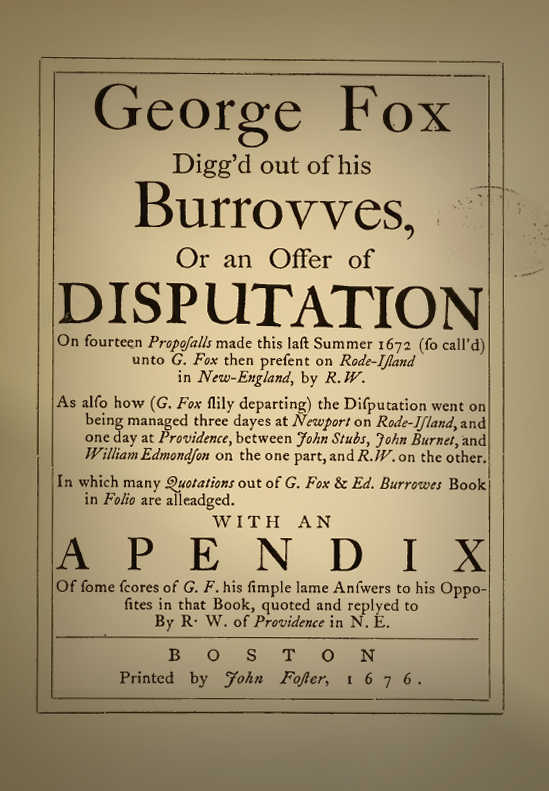
Quakers were welcomed at Providence. Quakers believed one is guided by an inner light. This teaching that upset the other colonies, but not in Providence! Quakers were welcome. Other colonies tried to bully the Providence leaders into punishing Quakers and the friends of Quakers. They resisted.
Although Roger Williams welcomed those with differing opinions, he relished in the opportunity to present his viewpoint. Even if you still disagreed, you still had his support so long as you obeyed the civil laws. For example, we know Roger Williams rowed himself all around Narragansett Bay. Famously, in 1672 at the age of about 69 or 70, he rowed alone, all night from Providence to Newport to debate the Quakers. The first session of the debate was held on August 9, 10, and 12th of August 1672 in Newport. On the 17th, discussions resumed one more day in Providence. Many attended both sessions. Williams’ recorded his account of the debates and John Foster printed a book of those notes in 1676.
1673: Indian Trial with Jury of Peers
One more example of fair treatment of Native Americans. The General Assembly passed a law in 1673 that every person who sold liquor, so that anyone became drunk, or who kept a gaming house, should be fined six shillings. Constables were appointed to watch on the first day of the week. Soon after, a trial by jury of a Native American took place where half of the jury were Native Americans.
1675-1678: Roger Williams and the King Philip’s War
The King Philip’s War started on Jun 20, 1675, and ended on Apr 12, 1678. In response to abuses by the English settlers, especially the taking of land, the Native tribes launched a conflict that lasted three years from 1675-1678. An elderly Roger Williams played a key role in the conflict. At the urging of Roger Williams, the Narragansett natives maintained neutrality during the early months of King Phillip’s War. In October of 1675 with Roger’s help, the Narragansett signed a treaty of neutrality with the Massachusetts Bay Colony promising they would not join with Phillip. Of course, the English attacked the Narragansett killing several so the Narragansett felt they could no longer trust the English.
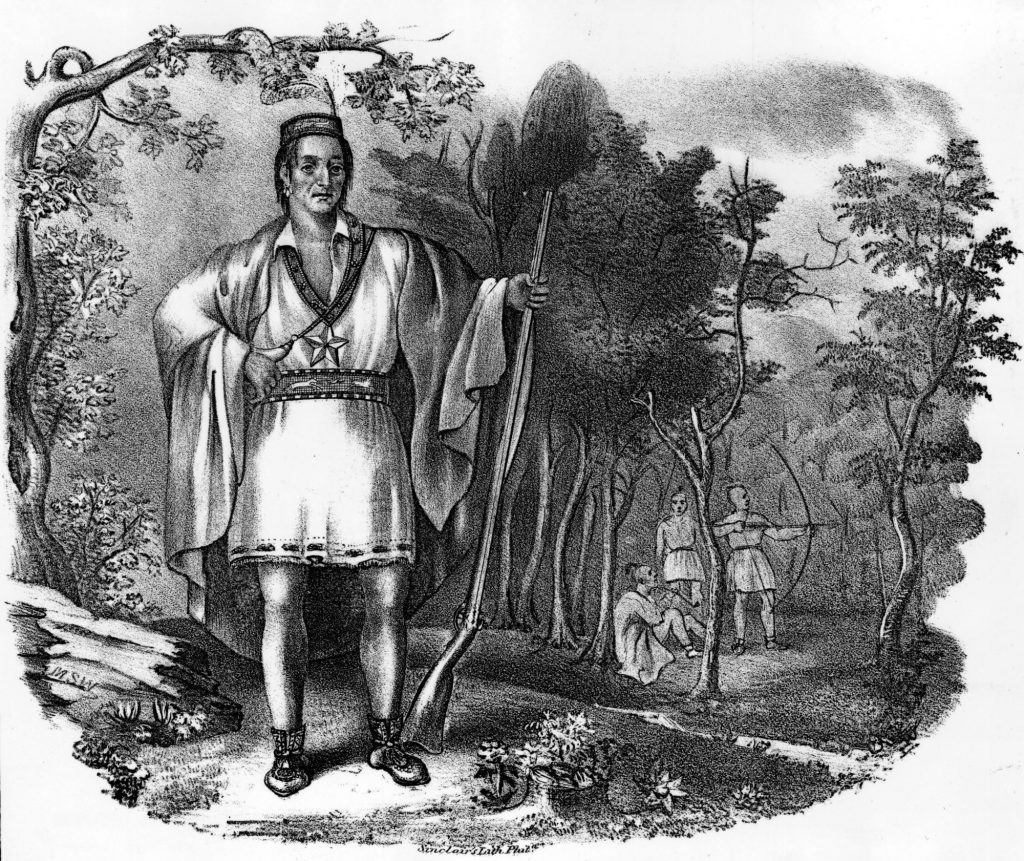
Later in 1676, a large army of about 3,500 native warriors led by chief sachem Canonchet marched north along the coast destroying the towns of Wickford, Warwick, and Pawtuxet along with almost all of the mainland settlements and farms. Roger went out to meet with the native leaders. Their discussions began with Roger scolding the Narragansett for becoming involved in the war. That led nowhere so he attempted to bluff them by saying they were not good fighters, and that 100 English could hold them off. His bluff was called and the Narragansett accepted a face-off between 100 English and 100 Narragansett. He reacted by doing what he was known to do best, negotiate. He asked for the Narragansett to give him their demands so he could negotiate for them. His proposal was rejected. When Roger turned to walk away. He was warned by the natives that there were some young braves on his side of the river that might ‘do him some mischief,’ and he could safely return to the blockhouse by walking along the water’s edge.
The natives burned most of Providence. Roger’s home and crops were among those burned. Roger survived and helped rebuild Rhode Island, but mainly focused on Providence. For a time, he lived in his son Joseph’s home. He led the first meeting after the war outside under a tree.
1676: Death of Wife Mary
Roger’s wife Mary reached 66 years of age and died in Providence in 1676 about a year into the King Philips War. I have yet to find a record of how she died.
1679-1683: By “Treachery and Seduction”: Indian Baptism and Conversion
The topic of this final work discovered some 300+ years later was on baby baptism vs true believers by choice.
Treachery and Seduction
This book was published for the first time in April 2014. At times, paper was scarce so on occasion Roger used existing books to write down his thoughts. Near the end of his life, Roger Williams scrawled an encrypted essay in the margins of a colonial-era book. This unpublished scribbles or “essay” is believed to be Roger Williams’ final treatise. For more than 300 years those shorthand notes remained undeciphered until a team of Brown University undergraduates cracked the code. In 1679, a debate on infant versus believer’s baptism had taken shape in both New England and old. Amazingly, Williams’ unique shorthand code contained a previously undiscovered essay, which was a point-by-point refutation of the famous Puritan John Eliot who was the “Apostle to the Indians”. Eliot’s book supported infant baptism.
1683: Death
Roger lived a long productive life. When he was about 80, he wrote to Governor Bradstreet saying:
“I am old and weak and bruised (with rupture and colic), and lameness on both feet.” –Roger Williams, May 6, 1682.
Roger died in his beloved Providence about April 1683, at the age of about 80 or 81–his birth year is still in question but believed by most today to be 1602 or 1603.
Burial
Both Roger and Mary were buried in Providence. Roger was laid to rest three times! He was first buried behind his house on Towne Street (now N. Main Street). In 1860, the family moved his remains to the family crypt in the Old North Burial Ground. They formed a committee to create a memorial to Williams and selected Prospect Terrace as a suitable final resting place. However, they lacked the funds and the Civil War broke out. Plans were put on hold. Later, in 1936, a new committee was formed to mark the 300th anniversary of the founding of Providence. They raised funds and interred the remains under a statue of Williams at Prospect Terrace–the location chosen by the first committee back in 1860.
The Shoulders of Giants!
Roger Williams accomplished much in his lifetime and arguably is the founder of modern American society. Our American history was built on the shoulders of giants. Roger Williams is one of those giants. He influenced progressive and liberal thinking in both New England and Old England during his lifetime.
His greatness isn’t that he was the first person to think of these ideas and concepts. Many before him thought of these things and kept them relatively private, were tamped down by some means, or failed to plant lasting seeds. Roger Williams’ greatness is the fact he was able to sow the seeds of modern society all around the world. His contributions lead to the founding of America, oldest constitutional republic in the world.
He was born in England where church and state were intertwined in enforcing all laws including enforcing religious doctrine. He died about 80 years later in Providence where church and state were separate and a citizen had complete freedom of thought. And, he had a major role in that change here in America, back in England, as well as other colonies around the world.
His input had a lasting influence around the world. The American liberal progressive movement goes back to the very beginning of the American colonies in the 1630s, and directly influenced our founding fathers. To this day, the official name of Rhode Island is the “State of Rhode Island and Providence Plantations”.
Roger Williams References:
- Roger Williams Wikipedia page
- Roger Williams Family Association — genealogy data.
- History.com Roger Williams page
- Smithsonian.com Roger Williams article
Additional R.W. articles by Mike Prestwood:
- The American Tradition of Separation of Church and State
- Was Roger Williams a Separatist?
- Roger Williams Timeline
- Roger Williams Gallery
- Robert Williams
- Read PDF Book: Ancestors of Adelbert P. Thayer, Florine Thayer McCray with MP Family Notes
- Read PDF: New England’s Memorial by Nathaniel Morton, published 1669 with MP Family Notes
- Research: Our Family Connection to Roger Williams
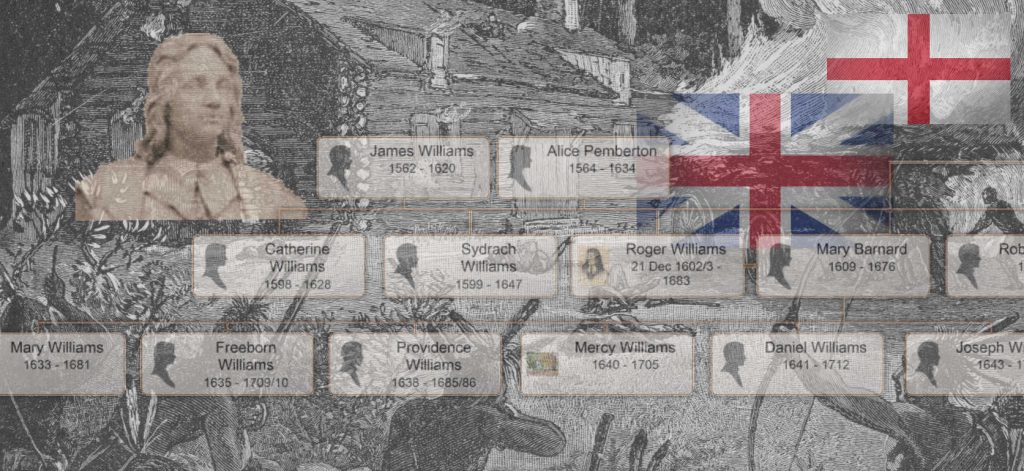


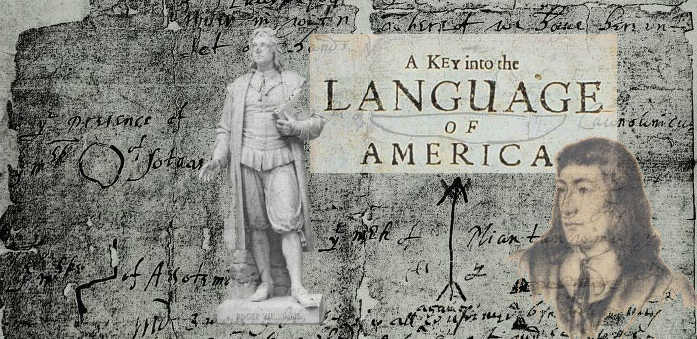


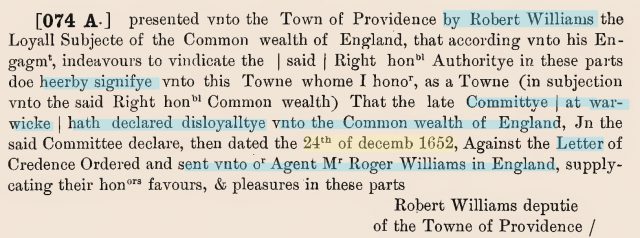








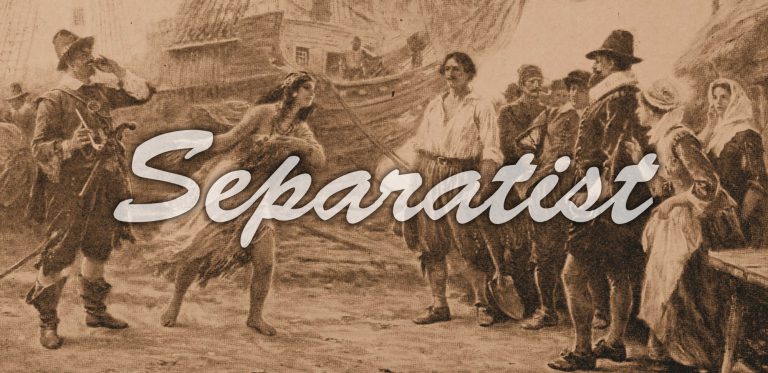
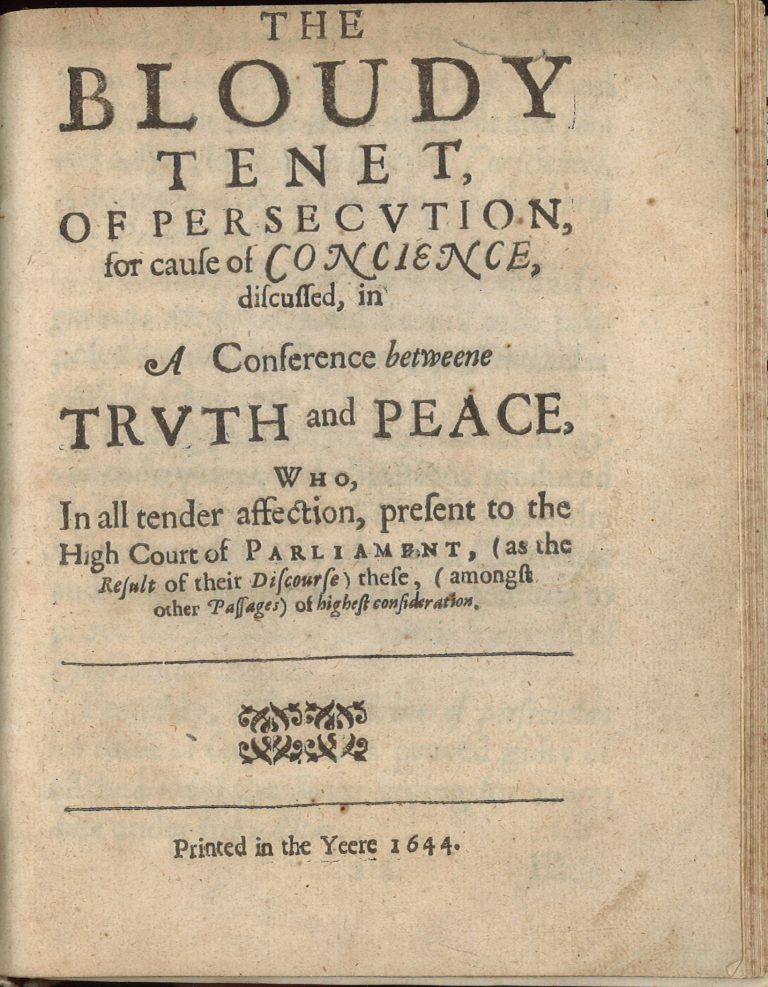
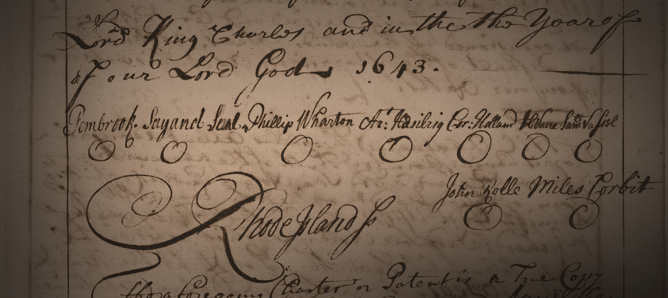

2 thoughts on “Roger Williams Biography and Dedication to the Freedom of Conscience”
Hi Joanne,
Always nice to meet a cousin! I post family genealogy stuff to https://family.prestwood.com, check it out. I post general info on Roger Williams on this blog. He was da bomb and I was excited to learn he was my 10th great-grandpa.
Mike Prestwood
Hey Mike. Roger is my kids’ tenth great grandpa (and my husband’s ninth), so I guess ya’ll are related (Rhode Islander here using my new Texan slang). 🙂 Joanne Hall